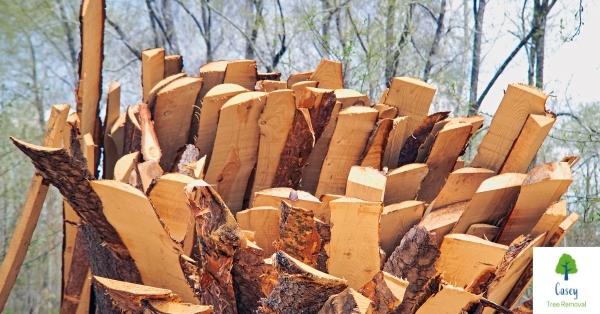We are living in an ever-changing environment – even if the change is slow. There are various reasons behind the changes – both man-made and natural – and these are making changes that are hard for the environment to deal with.
The major issues are pollution and climate change. While many (including scientists) cannot agree with the reasons behind climate change, it is evident that we are facing a huge global challenge.
What Is Tree Surgery Waste?
Tree work waste generally belongs to one of three categories:
- Timber
- Wood chip
- Non-chippable waste (e.g., minor pruning, hedge trimmings, sweepings from the ground).
How Can Tree Surgeons Help?
Tree surgeons can adjust their practices to adopt which are more environmentally friendly. One of the ways they can do this is by turning the ‘green waste’ they produce into fuel.
How Can Green Waste Be Fuel?
For trees to grow, they use carbon dioxide (CO2). Carbon gets used in the tree’s structure during growth. It is locked up into the molecules that build the tissues of the plant, for example in cellulose. When the tree reaches felling age and becomes fuel, it re-releases its CO2 collected over the years into the atmosphere. This is then re-used again by other growing trees.
When fuel is from a sustainable source like wood, it is great for the production of something called biomass. This means that branches and logs are reduced to chippings, which are then used by power stations to generate electricity. Biomass is both clean and sustainable.
Of course, the whole process needs to have a low carbon footprint, otherwise, the whole process will be a waste of time. This means that the processes of felling, extracting, chipping, and transporting to end-users need to have low carbon footprints.
How Is Green Waste Turned into Chips?
This is a really simple process. Wood chips for power stations and small boilers must be a consistent size. The sizes can vary between 30 mm and 50 mm per chip. When burning wood chips in boilers, we also need to be mindful of the chips’ moisture content. For the boilers to be as efficient as possible, the wood chips must have a moisture content below 30%. To ‘dry out’ the wood, it is stacked up so that there is sufficient aeration.
How Does Chipping Happen?
A woodchipper or tree chipper reduces the wood to small chips. Chippers are usually portable and are mounted on frames with wheels that can be towed. Generally speaking, the power is provided by an internal-combustion engine. Usually these are between 3 and 1000 horsepower or 2.2 kW to 750 kW. Higher power chippers can be mounted on a truck with a separate engine. These usually have hydraulic cranes too.
A wood chipper usually consists of a collared hopper, a chipper mechanism and sometimes a chip collection bin. The collar helps keep unwanted items (like body parts!) away from the blades of the chipper. A tree branch is put into the hopper, goes through the chipping mechanism and the chips come out of a chute. The chips can be directed onto the floor or into a container or truck.
How Else Can Woodchips Be Used?
Aside from fuelling boilers and power stations, woodchips can be used to produce mulch for paths or gardens. For woodchips to be converted into mulch, they will be stored for a few months so that they compost. If you spread fresh mulch on gardens, it could have adverse effects on any plants growing there. This is because the bacteria that break the wood down uses nitrogen, which means this will be stripped from the soil. Allowing the wood chippings to compost before they are used to avoid this happening.
What About the Non-chippable Waste That Tree Surgery Produces?
Trimming hedges creates a huge amount of material that cannot be processed by chippers. Also, any materials that are swept up or raked can’t be chipped either because it will be contaminated with grit and soil, which can cause damage to the chipper blades. It is possible to shred non-chippable waste and this can also be used at some power stations as a biomass fuel.
What Further Work Can Tree Surgeons Do to Have a Positive Impact on The Environment?
As mentioned above, it is as important to have a low carbon footprint. Tree surgeons can process things in bulk to save energy and journeys. They can also look to sell the waste products like woodchip and mulch locally so that the carbon footprint is reduced in this way too.
Tree Surgery Waste – Final Thoughts
It is great to see that so many solutions are now available for tree surgery waste. Whether chipped for biomass fuel or used as mulch, tree surgery these days can help the environment. As long as tree surgeons abide by the laws and try to keep the whole process as carbon neutral as possible, there is no reason to worry about the environmental impact of the wastes they produce.
Casey Tree Removal – All Tree Services including Tree Cutting, Tree mulching, Tree Trimming, Stump Grinding, Tree Pruning, Stump Removal, Emergency Tree Removal Experts In Melbourne!
Click here to read more articles regarding tree removal & related services.
If you are in Dandenong South and looking for Casey Tree Removal, below is the best way to visit us.


Recent Comments